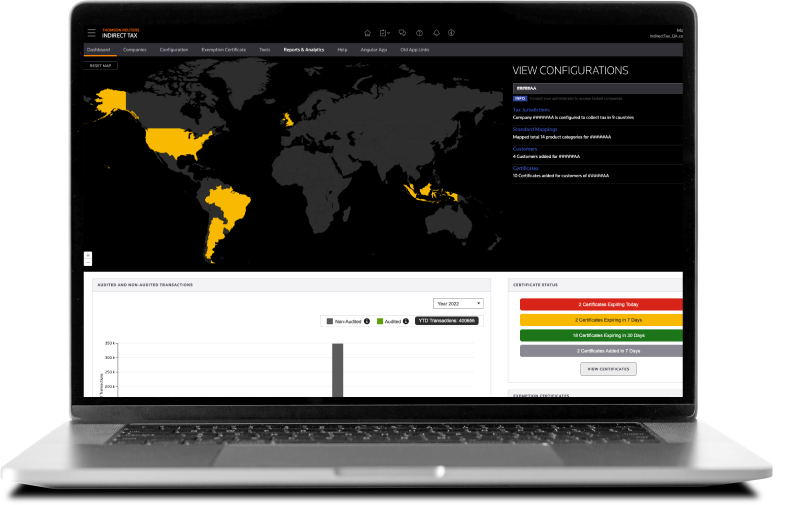The role of IT is to support and maintain the systems that businesses use to calculate and manage indirect taxes (DT), ensuring that these systems are updated to reflect changing tax laws and regulations.
With frequent changes in indirect tax laws, IT teams face the added challenge of continuously updating systems to ensure compliance. They have to quickly respond to requests for tax data while also maintaining security, protecting sensitive financial information, and ensuring that all IDT systems are fully functional, 24 hours a day. Failure to calculate and report indirect taxes correctly can be costly, resulting in extensive audits, hefty penalties, lost revenue, and potential harm to the brand.
Meeting the IT challenge through digital transformation
For IT, meeting these myriad challenges can be tough for companies that have not begun (or are still in the early stages of) their digital transformation journey. Companies may still be relying on a patchwork of legacy systems and performing some, or all their tax calculations using spreadsheets and database software. This situation can test the time and patience of even the most competent IT professionals.
In today’s digital age, most companies have transitioned to digital operations and no longer rely on traditional manual processes. Those organizations that have fully or largely digitized their operations (including IT infrastructure, a crucial aspect of IDT management) don’t strain their IT resources. Instead, the IT burden is significantly alleviated by an automated, end-to-end solution seamlessly connected to the company’s Enterprise Resource Planning (ERP) platform and other digital tools, all integrated via the cloud.
Unfortunately, companies can’t digitally transform their processes by snapping their fingers. A great deal of planning is involved, and if Tax is not brought into the conversation early, IT teams can be left juggling the responsibilities of modern indirect tax (IDT) management without the requisite tools or resources.
IT must help guide the conversation
The ideal time for a company to consider an automated, end-to-end tax solution is at the beginning, or in the early stages, of its digital transformation. IT must prioritize IDT management and coordinate with other relevant departments, specifically tax, to ensure that an optimal solution is implemented.
What all parties need to understand is how indirect taxes impact their organization, and why an automated IDT solution is the only practical way to meet the demands and reporting requirements of the digital age.
Surviving in a world of increasing tax complexity
The fact is, that organizations are being pressured by tax authorities around the world to adopt real-time reporting and e-invoicing, both of which require IT systems that consistently transmit clean, reliable data to the host government almost immediately. These same tax authorities are also tightening regulations and increasing penalties for those who don’t comply, so it is in every company’s best interest to have an IT infrastructure that can support compliance with tax regulations across all regions of the business.
Indirect taxes such as sales and use and value-added tax (VAT) are further complicated by the fact that tax regimes are always changing their requirements; different products and services are taxed according to different rules and rates; and different states, municipalities, and countries have different regulations and compliance procedures.
Without an automated tax solution to keep track of these ever-changing rules and regulations, companies lack visibility and risk a great deal. Potential audit penalties and fines are just the beginning. If taxes are calculated incorrectly and are being overpaid, for example, the company may be inadvertently leaking revenue. And in countries that require real-time reporting, non-compliance can prevent the business from operating in those regions altogether.
The key: Cloud-based automation and integration
Once digitalized, the advantage of integrating an automated, centralized cloud-based indirect tax solution with a company’s ERP and other business systems is that it globally guarantees standardized processes, accurate tax calculations and compliance. By its very nature, such a system eliminates the need for the kinds of systems workarounds and coding updates that can consume so much of an IT staff’s time at companies still reliant on outdated infrastructure.
There are other advantages as well. A robust IDT software solution can also help tax teams collect and analyze tax data without IT intervention and support, identify trends, develop money-saving tax strategies, and respond more quickly to audits and data requests. Cloud-based solutions can be more scalable, which means the system’s capabilities can expand according to the needs of the organization, without putting additional stress on IT staff.
Prioritize tax management, and plan ahead
Combined, these capabilities can improve the tax department’s performance and boost the overall efficiency and effectiveness of IT, which can in turn drive business growth and profitability. Indeed, the goal of any digital transformation is to future-proof the organization against obsolescence and create a more adaptable, resilient technical ecosystem.
Indirect taxes are an important part of this digital conversation. But for a company to enjoy a smooth transition toward an all-digital IDT system, early communication and planning between IT, leadership, and other relevant departments is paramount. To ensure a positive outcome, IT managers must anticipate the organization’s future needs and make the fast, accurate calculation of indirect taxes a top priority.
 |
|
 |
|